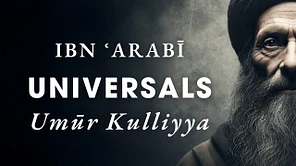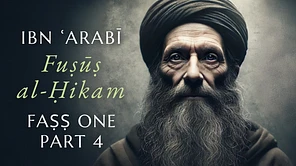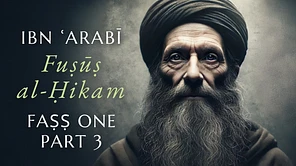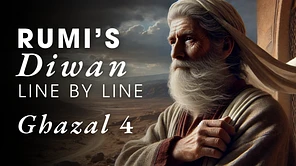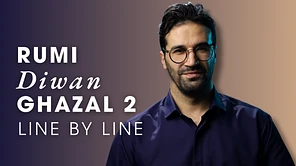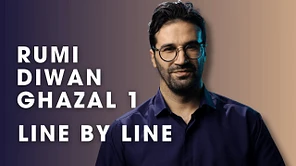Ghazal 162 of Dīwān-i Shams Tabrīzī
تو مرا جان و جهانی، چه کُنم جان و جهان را؟
تو مرا گنجِ رَوانی، چه کُنم سود و زیان را؟
You are my soul and my world; what need have I of the soul and the world?
You are my flowing treasure; what need have I of profit and loss?
نَفَسی یارِ شرابَم، نَفَسی یارِ کَبابَم
چو درین دورْ خَرابَم، چه کُنم دورِ زمان را؟
One breath I companion with wine, another with grilled meat;
Since I am ruined in this cycle, what care have I for the wheel of time?
نَفَسی یارِ شرابَم، نَفَسی یارِ کَبابَم
چو درین دورْ خَرابَم، چه کُنم دورِ زمان را؟
One breath I companion with wine, another with grilled meat;
Since I am ruined in this cycle, what care have I for the wheel of time?
زِ همه خَلْق رَمیدَم، زِ همه بازرَهیدَم
نه نَهانَم نه پدیدم، چه کُنم کَوْن و مکان را؟
I have fled from all creation, I am freed from all;
I am neither hidden nor manifest; what care have I for the world?
زِ وصالِ تو خُمارَم، سَرِ مَخلوق ندارم
چو تو را صید و شکارم، چه کُنم تیر و کَمان را؟
I am intoxicated with union with you, I care not for creation’s affairs;
Since I am your prey and your catch, what care have I for bow and arrow?
چو من اَندَر تَکِ جویَم، چه رَوَم آب چه جویَم؟
چه توان گفت؟ چه گویم صِفَتْ این جویِ رَوان را؟
As I am immersed in the stream, why should I chase water?
What can be said? What should I describe of this flowing stream?
چو نَهادم سَرِ هستی، چه کَشَم بارِ کُهی را؟
چو مرا گُرگْ شَبان شد، چه کَشَم نازِ شَبان را؟
Since I have laid down the burden of existence, why should I carry the weight of mountains?
Since the wolf has become my shepherd, why should I deal with the shepherd’s attitude?
چو من اَندَر تَکِ جویَم، چه رَوَم آب چه جویَم؟
چه توان گفت؟ چه گویم صِفَتْ این جویِ رَوان را؟
As I am immersed in the stream, why should I chase water?
What can be said? What should I describe of this flowing stream?
چه خوشی عشق چه مَستی، چو قَدَح بر کَفِ دَستی
خُنُک آنجا که نِشَستی، خُنُک آن دیدهٔ جان را
What joy are you, O love, what intoxication, when you have the goblet in hand!
Blessed is the place where you sit; blessed is the sight of the soul!
زِ تو هر ذَرّه جهانی، زِ تو هر قطره چو جانی
چو زِ تو یافت نشانی، چه کُند نام و نشان را؟
From you, each atom becomes a world, each drop a soul;
When a sign is found of you, what use are name and sign?
جِهتِ گوهرِ فایِق، به تَکِ بَحرِ حقایِق
چو به سَر باید رَفتن، چه کُنم پایِ دَوان را؟
For the ultimate gem, I dive into the ocean of truths;
Since I must ascend with my head, what care have I for running feet?
به سِلاحِ اَحَدی تو، رَهِ ما را بِزَدی تو
همه رَختَم سِتَدی تو، چه دَهَم باجسِتان را؟
With the weapon of unity, you seized our path;
You took all my belongings; what can I offer the tribute-gatherer?
زِ شُعاعِ مَهِ تابان، زِ خَمِ طـُرّهٔ پیچان
دلِ من شُد سَبُک ای جان، بِدِه آن رَطْلِ گِران را
From the glow of the shining moon, from the curls of the winding hair,
My heart has become light, O soul; now give me that grand goblet!
مَنِگَر رنج و بَلا را، بِنِگَر عشق و وَلا را
مَنِگَر جور و جَفا را بِنِگَر صد نِگَران را
Do not look at the suffering and trials; look at love and friendship.
Do not gaze at tyranny and cruelty; behold the hundred worried gazes.
غَم را لُطْف لَقَب کُن، زِ غَم و دَرد طَرَب کُن
هم ازین خوب طَلَب کُن، فَرَج و اَمن و اَمان را
Name sorrow as grace, be joyous in sorrow and pain.
From this, seek relief, safety, and peace.
بِطَلَب اَمن و اَمان را، بِگُزین گوشهگِران را
بِشِنو راهدِهان را، مَگُشا راهِ دَهان را
Seek safety and peace, choose a silent retreat;
Listen to the path of the mouth but do not open the path of the mouth.
Self-Study Guide: Hermeneutic Analysis of Rumi’s Ghazal 3 from Dīwān-i Shams Tabrīzī
This self-study guide follows a systematic hermeneutic approach to analyzing Persian mystical poetry, applying it to Rumi’s Ghazal 3 from the Dīwān-i Shams Tabrīzī. The goal is to provide a structured method for personal engagement with the poem, allowing for deeper understanding of its mystical, philosophical, and symbolic dimensions.
1. Principles of Hermeneutics in Rumi’s Poetry
Before beginning the analysis, familiarize yourself with key hermeneutic principles relevant to Persian mystical poetry:
- Textual Depth – Understand that Rumi’s words operate on multiple levels: literal, symbolic, and mystical.
- Hermeneutic Circle – Interpret individual verses in relation to the whole poem and vice versa.
- Fusion of Horizons – Engage with the text by merging your perspective with Rumi’s historical and spiritual context.
- Contextualization – Consider historical, cultural, and philosophical influences.
- Multiplicity of Meaning – Allow for diverse interpretations without seeking one final meaning.
2. Preparation for Analysis
To fully appreciate ghazal 3, consider these preparatory questions:
2.1 Historical, Cultural, and Philosophical Context
- Who was Rumi, and how did his life experiences shape his poetry?
- How does Sufism inform the poem’s themes?
- What socio-political and spiritual dynamics were present in Rumi’s time?
Research the historical and philosophical background of Sufism and how it influenced Rumi’s worldview.
3. Identifying Key Themes and Symbols in the Poem
3.1 Guiding Questions
- What are the dominant themes of ghazal 3?
- How does Rumi use self-dialogue to address human shortcomings?
- What metaphors or symbols does he employ to express spiritual struggles?
3.2 Themes in Ghazal 3
- Self-Examination – Rumi questions the heart’s failures in faithfulness.
- Divine Generosity vs. Human Frailty – The contrast between God’s endless Grace and human inconsistency.
- The Journey to Transformation – Trials as a means of spiritual growth.
- Longing for the Divine – True fulfillment lies not in paradise but in divine Presence.
3.3 Symbolism in the Poem
- Bead in Hand – Symbolizes submission to Divine will.
- Tasting & Pulling – Life’s trials as purification for the soul.
- Prophet Shuʿaib’s Cry – The yearning for divine closeness.
4. Contextual Interpretation
4.1 Understanding the Poem’s Historical & Mystical Context
- How does Rumi’s life, influenced by his mentor Shams Tabrizi, shape this self-reflective dialogue?
- What Islamic and Sufi theological concepts underpin the poem’s messages?
4.2 Applying Key Principles
- Intertextuality – Compare Rumi’s self-examination with Quranic themes of human accountability and divine Mercy.
- Cultural Embeddedness – Consider how Persian poetic traditions of self-dialogue enhance the poem’s message.
5. Structural Analysis
5.1 The Poem’s Form and Flow
- What is the overall structure? The poem follows a reflective progression—self-questioning, realization, and ultimate longing.
- How does rhyme/meter enhance meaning? Persian ghazals use rhythmic patterns to create musicality and emotional depth.
- How do individual verses contribute to the whole? Each verse builds on the last, leading to a climactic realization about longing for the Divine.
5.2 Poetic Devices
- Parallelism & Contrast – Divine generosity vs. human failure.
- Imagery & Metaphor – Sensory experiences (tasting, pulling) symbolize preparatory practices for spiritual refinement.
- Repetition – Intensifies themes of longing and submission.
💡 Suggested Activity: Mark key poetic devices in the Persian text and explore their impact.
6. Layered Interpretation
Use a step-by-step interpretive approach:
- Literal Meaning – Rumi questions the heart’s failures.
- Symbolic Meaning – The poem criticizes spiritual blindness and calls for accountability.
- Philosophical Meaning – Human trials refine the soul for divine closeness.
- Mystical Meaning – True paradise is not a material reward but divine vision and union.
7. Handling Ambiguity
Rumi’s poetry thrives on paradox. Consider:
- How does the ambiguity in metaphors (bead in hand, tasting, hell vs. paradise) deepen meaning?
- Why does Rumi reject paradise if it lacks divine vision?
- How does the poem’s open-ended nature invite personal reflection?
8. Integration of Reader and Text
- What personal biases shape my reading of Rumi’s poem?
- How does this poem challenge or expand my spiritual understanding?
- What personal insights emerge from engaging with Rumi’s self-dialogue?
💡 Suggested Activity:
Write a personal meditation in response to Rumi’s self-inquiry.
9. Synthesis of Insights
9.1 Final Reflections
- How does Rumi’s message of self-examination apply to contemporary struggles?
- What does this analysis reveal about Persian mystical thought?
- How does this poem contribute to broader philosophical and theological discussions?
9.2 Key Takeaways
Conclusion: Living Rumi’s Message
By following this hermeneutic analysis, you’ve engaged deeply with Rumi’s mystical poetry. His words encourage an ongoing dialogue with our own hearts—challenging us to move beyond superficial spirituality toward profound self-awareness.
Final Reflection Question:
How can you apply Rumi’s wisdom in your daily spiritual practice?
By analyzing Ghazal 3 through this structured framework, you are not just reading Rumi—you are engaging in a transformative journey of self-discovery and divine longing.
🌿 “Transcend worldly desires, and seek the divine Beloved.”



